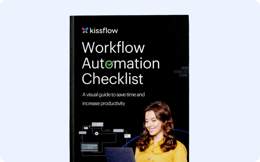
- >
- Workflow Platform >
- What is Workflow Automation? - A Complete Overview
What is Workflow Automation? - A Complete Overview
Team Kissflow
Updated on 18 Jun 2025 • 13 min read
What if your team could stop drowning in repetitive tasks and focus on big wins? Workflow automation makes that possible. By replacing manual processes with automated workflows, businesses are not just saving time-they're unlocking productivity, minimizing errors, and setting the stage for more intelligent decision-making.
Think about it: How much more could your team achieve if routine approvals, follow-ups, and updates happen automatically? Whether you’re dealing with IT bottlenecks, slow approvals, or endless data entry, a workflow automation software transforms these pain points into opportunities for growth.
Ready to learn how business workflow automation can change the way your business works? Let’s look into everything you need to know about workflow automation, from its benefits to overcoming challenges and best practices for success after adopting a workflow automation software.
What is workflow automation?
Workflow automation is an approach to making the flow of tasks, documents and information across work-related activities perform independently without human-intervention. It invloves the use of a workflow automation software that makes work faster, easier, and more reliable. Companies adopt workflow automation softwares to minimize manual work and automate repetitive tasks. This can include tasks like sending automated emails, managing customer data, or even streamlining new hire integration through an HR onboarding app.
For example, automating employee onboarding replaces tedious paperwork with a simplified process. It ensures compliance, enhances efficiency, and allows HR teams to dedicate more time to fostering talent and improving employee experiences.
Workflow process automation helps businesses streamline repetitive tasks, reduce manual errors, and accelerate approvals across departments with minimal human intervention.
- Chris Gardner, VP, Research Director at Forrester
Notably, 78 percent [1] of business leaders report that automation has significantly increased organizational productivity.
Trying to solve your hassles with workflow automation?
Automating workflows has become a cornerstone for organizations striving to enhance efficiency and reduce operational burdens. By replacing manual processes with automated ones, businesses unlock numerous advantages—from streamlined task execution to fewer human errors—that drive productivity, accuracy, and growth. Implementing tools like an automated expense management system is a prime example, helping teams manage reimbursements, approvals, and reporting with ease. With the right tools, workflow process automation can transform complex business operations into efficient, rule-based systems that boost productivity and transparency. Here are the key benefits in detail:
Benefits of workflow automation
1. Time savings
A Workflow automation software eliminates the delays caused by repetitive, manual tasks, allowing businesses to operate more efficiently. For example, instead of manually processing invoices, an automated workflow can route them directly to the appropriate approver, send reminders, and schedule payments once approved. This approach of automated workflows accelerates the process and reduces the likelihood of bottlenecks.
Statistics quote that businesses save an average of 15-20 hours per week [2] per employee by automating routine workflows.
2. Improved accuracy
Manual processes are prone to errors, such as data entry mistakes, missed deadlines, or misfiled documents. A workflow platform minimizes these risks by standardizing tasks and applying error-checking mechanisms.
3. Enhanced collaboration
Teams often face challenges in maintaining alignment due to poor communication or a lack of transparency. A workflow automation platform bridges these gaps by providing real-time updates, shared dashboards, and automated notifications. For example, in project management, automation tools keep all stakeholders informed of deadlines, changes, and task progress, ensuring that teams work cohesively toward shared goals.
4. Process transparency
A workflow automation platform tracks every task and decision point, creating an auditable trail. Due to this level of transparency, organizations can pinpoint inefficiencies, improve accountability, and ensure compliance with industry regulations. For example, in procurement, automated workflows provide visibility into vendor approvals, purchase requests, and payment statuses, enabling better oversight and control.
5. Increased productivity
Automating repetitive tasks allows employees to focus on more meaningful and strategic work. For instance, customer service teams can automate ticket assignments and status updates, allowing agents to dedicate more time to resolving complex customer issues rather than managing administrative tasks. This adoption of workflow automation system not only boosts productivity but also enhances job satisfaction.
6. Faster decision-making
Automation provides real-time data and insights, enabling quicker and more informed decision-making. For example, marketing teams can use automated workflows to analyze campaign performance in real-time, adjust budgets, and optimize strategies instantly rather than waiting for manual reporting. This agility is essential in competitive markets.
7. Consistency and compliance
Automated workflows ensure that processes are followed consistently across the organization. This standardization is critical in industries with strict compliance requirements, such as healthcare and finance. For example, healthcare providers can use automation to update patient records accurately and consistently, reducing the risk of compliance violations or legal issues.
8. Cost efficiency
Although not always highlighted, cost savings are a significant benefit of workflow automation. Businesses save on operational expenses by reducing manual labor, preventing errors, and improving resource allocation.
Streamline your tasks with the power of workflow software and automation.
Tired of IT bottlenecks? Discover how workflow automation can transform your IT department:
Chief Information Officers
Strategic IT planning: Automate the tracking and managing of IT initiatives and align them with business goals.
IT governance: Implement automated workflows for policy compliance checks and audit trails to ensure adherence to governance frameworks.
Resource allocation: Use automated processes to allocate IT resources effectively based on project priorities and availability.
Chief Digital Officers
Digital transformation projects: Streamline the approval and execution process for digital transformation initiatives to ensure timely completion.
Innovation management: Automate the idea collection, evaluation, and implementation workflows to foster innovation within the organization.
Customer experience: Implement automated workflows to gather, analyze, and respond to customer feedback, enhancing the overall customer experience.
Business Transformation Heads
Change management: Automate change request approvals and tracking to ensure smooth transitions during business transformation efforts.
Performance monitoring: Use automated dashboards to track key performance indicators (KPIs) and measure the impact of transformation initiatives.
Stakeholder communication: Streamline communication workflows to keep all stakeholders informed about the progress and outcomes of transformation projects.

Workflow Automation Checklist: The Complete Guide for Business Owners
Thank you for Downloading!
IT Managers
Incident management: Automate it processes and the reporting, tracking, and resolution of IT incidents to minimize downtime and enhance service quality.
Service request fulfillment: Implement automated workflow softwares for handling IT service requests to ensure prompt and efficient service delivery.
Capacity planning: Using automated processes to forecast and manage IT capacity needs ensures optimal resource utilization.
Directors of IT
Project management: Automate project planning, scheduling, and monitoring to ensure timely delivery of IT projects.
Budget management: Implement automated workflows for budget approvals and tracking to maintain control over IT expenditures.
Vendor management: Use automated processes to manage vendor relationships, contracts, and performance evaluations.
VP of Applications
Application development: Streamline the development lifecycle with automated workflows for code reviews, testing, and deployment.
Application maintenance: Automate routine maintenance tasks and updates to ensure application stability and performance.
User feedback integration: Implement automated workflows to collect, analyze, and act on user feedback for continuous application improvement.
Heads of IT
IT strategy execution: Automate the execution and monitoring of IT strategies to ensure alignment with business objectives.
Security management: Implement automated security checks and incident response workflows to safeguard the organization’s IT infrastructure.
IT performance reporting: Use automated dashboards to generate real-time performance reports and gain insights into IT operations.
Learn more: Benefits of automation workflows.
Workflow automation statistics
Here are some key figures of industries that benefited from workflow automation:
-
417% increase in revenue: Process and marketing automation yields a 417% increase in revenue.
Read how Annuitas Group increased their revenue.
-
$270 million annual savings: Cisco Systems automated its CRM process, eliminating 75,000 customer calls per month and saving over $270 million annually in operating expenses.
Read more about annual savings here: Business Process Management Journal.
Key Areas of Anticipation: Businesses anticipate workflow automation in three areas: managing cost efficiency, improving time to market, and optimizing customer self-service.
Read more: Capgemini’s research.
How to automate workflow processes?
A workflow automation process begins with a clear objective and ends with a process evaluation.
Here are 5 steps involved in carrying out a workflow automation plan.

1. Identify a repetitive process
Zero in on a process that could benefit from automation. Ask questions such as ‘Is it mature enough to be automated?’ or ‘Does the team approve of or insist on automation?’.
2. Define goals
The benefits of automation can be varied - increased ROI, faster time-to-market, and increased team productivity. Clearly articulate your team’s expectations from automation.
3. Train the team
The success of workflow automation depends on the willingness of its stakeholders. Communicate its benefits to the process owners and encourage their feedback.
4. Design the workflow
Build the process in the workflow management tool. Create a form, define the workflow, and assign permissions and rules for each step and stakeholder.
5. Measure KPIs and ROI
The purpose of automation is not fully achieved until your business compares the difference it has made to the pre-existing processes measured through reports and data analytics.
Calculating the ROI of workflow automation
Understanding how to measure the return on investment (ROI) for workflow automation helps organizations make data-driven decisions and justify their investment. Here’s a structured approach to calculating and evaluating workflow automation ROI.
1. Quantify the costs
Before measuring the benefits, identify the total cost of ownership (TCO), which includes:
-
Initial investment: Software licensing, implementation, integration, and training costs.
-
Ongoing expenses: Subscription fees, support, and maintenance.
2. Measure time savings
Automation reduces the time required to complete tasks. To calculate cost savings:
-
Estimate the time saved per task (in hours).
-
Multiply it by the average hourly wage of employees performing the task.
-
Example: If a task that took 30 minutes is now done in 5 minutes and an employee earns $50/hour, the savings per task = $37.50.
3. Evaluate error reduction
Errors in manual workflows lead to financial losses due to:
-
Reworks and inefficiencies.
-
Customer refunds and chargebacks.
-
Compliance fines or penalties.
To quantify savings:
-
Track the average error rate before and after automation.
-
Multiply the reduction in errors by the cost per error.
4. Project revenue increases
For revenue-generating workflows, automation drives:
-
Faster execution of transactions, increasing order fulfillment rates.
-
Higher accuracy in sales or financial data, reducing revenue leakage.
-
Increased customer satisfaction, leading to repeat business.
Formula:
For revenue-generating workflows, measure the additional revenue gained from faster execution and improved accuracy.
5. Determine payback period
Calculate how quickly the investment pays for itself:
Payback period=Estimate how long it takes for the investment to pay for itself by dividing the total costs by the benefits.
A shorter payback period indicates a high-value investment.
Example calculation
A mid-sized e-commerce company automates order approvals and inventory restocking:
-
Time savings: 40% reduction in processing time.
-
Error reduction: 20% fewer errors.
-
Cost savings: $100,000 in operational savings annually.
-
Investment: $80,000 upfront.
-
Payback period: $80,000 / $100,000 = 0.8 years (~10 months).
Result: The company recoups its investment in less than a year, with ongoing savings beyond that.
Measuring success in workflow automation
To continuously evaluate the effectiveness of automation, track key metrics:
-
Time savings: Reduction in task completion time.
-
Cost reduction: Annual savings in operational expenses.
-
Error rate: Percentage decrease in manual errors.
-
Productivity metrics: Increase in high-value tasks completed per employee.
-
Employee & customer satisfaction: Measured through surveys and feedback.
By using these metrics, businesses can ensure long-term efficiency, cost savings, and scalability—making workflow automation a high-ROI investment.
Key challenges in workflow automation and how to overcome them
While workflow automation platforms offer transformative benefits, it's not without its hurdles. From resistance to change to technical integration issues, organizations often face challenges that can derail automation initiatives. Addressing these obstacles earlier ensures a smoother implementation and maximizes the impact of automation.
1. Resistance to change
One of the biggest roadblocks to implementing a workflow automation platform or a software is resistance from employees. Teams accustomed to manual processes may feel uneasy about adopting new technology, fearing it might render their roles redundant or require significant learning effort.
For example, an HR department might hesitate to use an hr workflow automation tool for onboarding system if they perceive it as threatening their personal touch in the hiring process.
Overcoming this resistance requires clear communication about how automation complements their work, rather than replacing it, by freeing them to focus on higher-value tasks like employee engagement.
Solution: Conduct training sessions, highlight quick wins, and involve employees early in planning to gain buy-in.
2. Undefined processes
A workflow automation platform cannot fix a broken process. Automation will only magnify the inefficiencies if workflows are poorly documented or inconsistent. For example, automating a chaotic procurement process with unclear approval hierarchies will lead to errors or bottlenecks.
Before automating workflows, organizations must clearly understand their workflows, including steps, responsibilities, and outcomes. Without this groundwork, automation can fail to deliver the desired results.
Solution: Map out existing workflows, identify inefficiencies, and refine processes before introducing automation. Tools like process mining software can help uncover bottlenecks.
3. Legacy system integration
Many businesses still operate with legacy systems. Integrating these older systems with newer automation platforms can be technically complex and resource-intensive.
For instance, a financial institution may struggle to connect its decades-old core banking software with a new workflow automation tool.
These integration challenges can lead to delays, higher costs, and frustrations during implementation. Additionally, mismatched systems can create data silos, where critical information remains isolated and inaccessible.
Solution: To ensure smooth connectivity, use automation platforms with robust integration capabilities, such as API support or pre-built connectors. Gradually phase out or modernize outdated systems when feasible.
4. Upfront investment
The initial cost of implementing workflow automation can be daunting, especially for small and medium-sized businesses. Costs include software licensing, hardware upgrades, employee training, and ongoing maintenance.
For instance, automating a supply chain process might involve investing in sensors, cloud storage, and advanced analytics software, straining budgets. Decision-makers may hesitate if the ROI isn't immediately apparent.
Solution: Start with smaller automation projects to demonstrate quick wins and ROI. Use these early successes to justify broader investments.
5. Data security concerns
Workflow automation platforms handle sensitive data, including customer information, financial records, and employee details. Protecting this data from breaches, unauthorized access, or misuse is critical.
Additionally, organizations must comply with regulatory standards like GDPR, HIPAA, or CCPA, depending on their industry and location.
For example, a healthcare provider automating patient records must ensure the platform adheres to strict data security regulations to avoid legal repercussions.
Solution: Opt for automation platforms with built-in security features like encryption, access controls, and audit trails. Regularly update systems to patch vulnerabilities and ensure compliance with relevant regulations.
Best practices for successful workflow automation
Implementing workflow automation is not just about technology; it’s about creating processes that are efficient, scalable, and aligned with business objectives. Following these best practices ensures that automation delivers long-term value and integrates seamlessly into your operations.
1. Document processes
Automation starts with understanding your existing workflows. Before implementing any automation tools, map out each step of the process, identify key roles, and establish dependencies. Clarity is crucial in automation implementation, as it helps minimize missteps and streamline the entire procedure.
For example, in a procurement workflow, document every stage—from purchase request initiation to vendor payment. Clearly define who is responsible for approvals and ensure all tasks align with organizational policies. This documentation acts as a blueprint for building automated workflows.
Why it matters: Without a clear understanding of the process, automation can amplify existing inefficiencies instead of solving them.
2. Review regularly
Automated workflows are not a "set it and forget it" solution. Regular evaluations help identify bottlenecks, inefficiencies, or new opportunities for improvement. As your business evolves and processes become more complex, it becomes imperative to stay organized and adaptable.
For instance, an automated customer support workflow might work well. However, as ticket volumes grow or customer needs change, the system may require updates to routing logic, escalation rules, or response templates.
Why it matters: Continuous optimization ensures that workflows remain efficient and aligned with organizational goals.
3. Engage stakeholders early
Automation impacts multiple teams, so involving stakeholders from the beginning is crucial. The workflows involve IT, process owners, and end-users who interact with them daily. Early engagement fosters collaboration, reduces resistance to change, and ensures the solution addresses the needs of all involved.
For example, when automating HR onboarding workflows, HR managers, IT, and team leads should be involved to capture the full spectrum of requirements, from compliance checks to IT setup for new hires.
Why it matters: Gaining buy-in and feedback from stakeholders leads to smoother implementation and higher adoption rates.
4. Use metrics to measure success
Define key performance indicators (KPIs) before rolling out automation. Metrics such as time saved, error reduction, or cost savings help evaluate the effectiveness of the automation. Use analytics dashboards provided by automation platforms to monitor performance in real-time.
For instance, track how automation impacts invoice processing times. If approval timelines drop from five days to two, it indicates success—similarly, measure reductions in manual errors to quantify improvements in accuracy.
Why it matters: Metrics provide measurable proof of ROI and help make a case for scaling automation across other areas.
5. Ensure scalability
Choose automation tools that can grow with your organization. Scalability is essential as workflows expand, processes become more complex, and new departments come online. Solutions with modular designs, integration capabilities, and support for large user bases are ideal.
For example, a growing company that starts with automating a single department, such as finance, may later need to automate HR, IT, or sales processes. A scalable platform ensures smooth expansion without the need for reimplementation.
Why it matters: A scalable solution avoids the need for costly replacements or overhauls as your business grows.
6. Incorporate user feedback
End-users interact with automated workflows daily, making their feedback invaluable for optimization. Gather insights through surveys, interviews, or monitoring usage patterns to identify pain points or additional needs.
For instance, employees using an automated travel expense workflow might request the addition of currency conversion for international travel. Incorporating this feedback improves the user experience and adoption.
Why it matters: User-driven improvements ensure workflows remain practical and relevant, leading to higher satisfaction and efficiency.
Kissflow: The smarter way to automate your workflows
Kissflow’s workflow automation platform delivers everything businesses need to simplify operations and drive efficiency. Its powerful features ensure seamless adoption, robust performance, and alignment with digital transformation goals.
User-friendly interface
Kissflow's intuitive drag-and-drop design lets business users create and manage workflows without relying on IT while allowing IT oversight. This ease of use accelerates adoption and implementation across teams.
Pre-built templates
Leverage an extensive library of ready-made templates for workflows like procurement, expense management, and employee onboarding. Customize them to fit your business needs and deploy workflows in minutes.
Seamless integrations
Integrate Kissflow effortlessly with ERP, CRM, and collaboration tools like Slack or Microsoft Teams. Unified systems ensure smooth data flow, eliminate silos and enable end-to-end automation.
Enterprise-grade security
With advanced data encryption, role-based access controls, and compliance with global regulations like GDPR and HIPAA, Kissflow ensures your processes are secure and compliant.
Comprehensive support
Kissflow offers dedicated resources, training, and 24/7 support to ensure a smooth automation journey and maximum ROI.
Tailored workflow automation for your business
Tired of bottlenecks slowing you down? Kissflow transforms your complex processes into streamlined operations. Our intuitive workflow automation software turns your ideas into powerful, custom solutions — without a single line of code. Watch productivity soar as tedious tasks become automated victories.
Solve your workflow challenges with Kissflow and optimize your team's productivity today!.
Why wait to transform your workflows?
Frequently Asked Questions (FAQs)
1. What is the definition of workflow automation?
Workflow automation is the process of using software to automatically complete repetitive tasks and business processes without human intervention. It helps teams save time, reduce manual errors, and improve overall productivity by automating steps in a workflow like approvals, data entry, and notifications.
2. What are the 5 stages of workflow?
The five key stages of a typical workflow are:
-
Initiation – Start of the process, like submitting a request or form.
-
Planning – Assigning roles and defining steps needed to complete the workflow.
-
Execution – Carrying out the tasks as per the plan.
-
Monitoring – Tracking progress, identifying delays or errors.
-
Completion – Final review, approvals, and closing the process
3. What are the four types of workflows?
The four common types of workflows are:
-
Sequential Workflow – Tasks follow a strict order, one after the other.
-
State Machine Workflow – Tasks can move back and forth based on decisions or conditions.
-
Rules-Driven Workflow – Steps are triggered by business rules and logic.
-
Parallel Workflow – Multiple tasks happen at the same time and merge later.
4. What are the 3 basic components of a workflow?
The three basic components of a workflow are:
-
Input – The data or request that starts the workflow.
-
Process – The steps or actions performed on the input.
-
Output – The final result or outcome after all steps are complete.
5. What are the 3 basic workflow management practices?
Three key workflow management practices include:
-
Workflow Design – Mapping out the steps and logic of the process.
-
Automation Setup – Using tools to automate repetitive tasks.
-
Monitoring & Optimization – Tracking performance and improving workflow efficiency over time.
6. What are examples of workflow processes?
Common workflow examples include:
-
Employee onboarding
-
Leave request approvals
-
Invoice processing
-
Purchase order approvals
-
Customer support ticket resolution
These workflows help streamline daily operations and improve consistency.
8. What is the difference between workflow automation and RPA?
Workflow automation focuses on automating a sequence of business processes using rule-based triggers in a structured workflow.
Robotic Process Automation (RPA) mimics human actions to perform tasks on a computer, like copy-pasting data between systems, often across unconnected apps.
In short:
-
Workflow automation = process-focused
-
RPA = task-focused and system-independent
9. How doesw AI improve workflow automation?
AI improves workflow automation by intelligently routing tasks based on content and priority, extracting information from unstructured documents, predicting potential bottlenecks before they impact performance, identifying patterns that trigger appropriate workflow actions without explicit programming, handling increasingly complex decision-making, and continuously learning from process execution to suggest improvements.
10. What industries benefit most from workflow automation?
Industries benefiting most from workflow automation include financial services (loan processing, compliance reporting), healthcare (patient scheduling, insurance verification), legal services (contract management, case processing), manufacturing (quality assurance, maintenance workflows), and government agencies (permit applications, citizen service requests).
11. What are common challenges in workflow automation?
Common challenges in workflow automation include integration difficulties with legacy systems, resistance to change from employees, data quality issues undermining automation effectiveness, difficulty capturing exception handling for edge cases, inadequate testing before deployment, underestimating the complexity of business rules, and failing to redesign processes before automating them.
Related Articles












